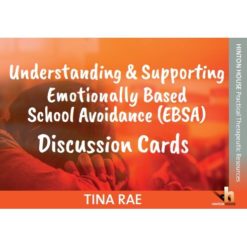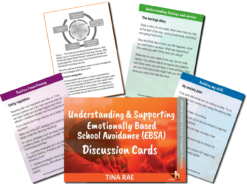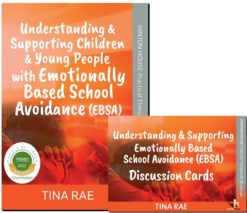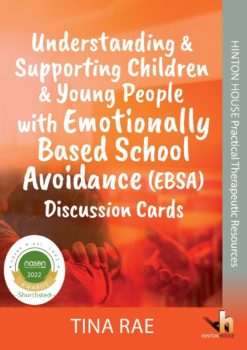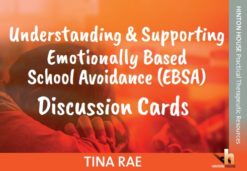Tina Rae
What Does EBSA Look Like? and Possible Triggers
EBSA is not in itself a mental health disorder, but rather it is a combination of symptoms that indicates that a young person is experiencing emotional distress relating to school attendance. This typically includes high levels of anxiety.
Pupils may exhibit one or more of the following associated behaviours:
- crying
- pleading
- refusal to get ready for school or to leave the house
- rumination and worry around school-related issues
- sleep problems
- psychosomatic illness
Psychosomatic illnesses, including headache and tummy ache, occur when no underlying medical cause can be found, and the basis is thought to be emotional. Thambirajah and colleagues (2008) describe how the child or young person may also display defensive aggression as a means of trying to control
a situation that feels ‘out-of-control’. Typically, this might be directed towards a parent or carer who is encouraging the child to go into school and may include verbal abuse or physical aggression directed at objects or people.
These behaviours can be seen as symptoms of anxiety and an attempt by the child or young person to avoid a situation that they perceive to be threatening.
There is an acknowledgement that just as the combination of factors contributing to EBSA are complex and largely unique to the individual and their family, symptoms and associated behaviours can also present in a variety of ways.
Professionals and parents/carers need to be aware that some pupils with EBSA appear to function well when they are in school. Likewise, they may happily socialise with friends outside school or attend specific clubs or activities. This can lead school staff and others to question whether a pupil is really experiencing EBSA and, in turn, can lead to potential misunderstanding with parents who are experiencing significant problems at the beginning or end of the school day.
Possible Triggers
Possible triggers include the transition between primary and secondary education, loss or bereavement within the family, or a change in friendship groups or bullying. Some pupils may find it harder to return to school following a prolonged absence, for instance due to illness or a school holiday.
A study by Toplis (2004) explored parents’ views of the causal and maintaining factors of EBSA. Parents reported a number of factors that they felt had contributed to school avoidance for their child. Although this was only a small study, consisting of eight parents, a number of commonalities between cases were
reported, including:
- verbal and physical bullying by peers
- feelings of isolation, anxiety or depression
- problems with academic work
- difficulties experienced after a school transition
- difficulties experienced after a distressing family event
As always, the exact combination of vulnerabilities will be unique to the individual and therefore requirescareful assessment.
The following factors may be a useful starting point for school staff in thinking about a pupil’s needs:
Child factors:
- difficulties with social interaction
- undiagnosed needs that make it hard to access the learning environment and curriculum
- feeling overwhelmed by academic or social demands
- medical difficulties
- temperament – some children may have a predisposition to developing problems relating to anxiety
Family factors:
- family events, such as divorce or separation, loss or bereavement
- the mental and physical wellbeing of parents
- the young person taking on the additional role of young carer for siblings or parent
School factors:
- size of the school
- bullying, including cyberbullying
- transition to secondary school and associated adjustment in terms of expectations and staff
- poor special educational needs or pastoral provision
Toplis’ research suggests that, while EBSA can occur at any age throughout an individual’s educational career, it tends to peak at times of transition: on entry to school (between 5 and 6 years old) and transition to secondary school (between 10 and 11 years old).
As well as being aware of the potential risk factors for EBSA, it is also important to consider protective factors that can support the individual and family. School-based protective factors, for instance, would include a transition policy with clear procedures for sharing information, including attendance data, on individual pupils.
Taken from Tina’s best-selling book,
Understanding & Supporting Children & Young People with Emotionally Based School Avoidance
a practical user-friendly toolkit of resources providing an overview of EBSA and strategies to support return to school.

Dr Tina Rae has more than 40 years’ experience working with young people and families in both clinical and educational settings. She currently works as a Consultant Educational & Child Psychologist in both SEMH and mainstream settings supporting foster carers, social workers and looked-after children. Tina is an award-winning author and has written more than 100 publications.





